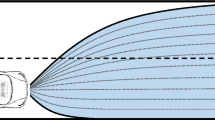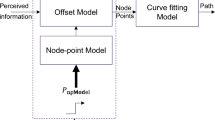Abstract
In the paper, an improved car-following model based on the full velocity difference model considering the influence of optimal velocity for leading vehicle on a single-lane road is proposed. The linear stability condition of the model is obtained by applying the linear stability theory. Through nonlinear analysis, the time-dependent Ginzburg–Landau (TDGL) equation and the modified Korteweg–de Vries (mKdV) equation are derived to describe the traffic flow near the critical point. In addition, the connection between the TDGL and the mKdV equations is also given. Good agreement between the simulation and the theoretical results shows that the improved model can be enhanced the stability of traffic flow.



Similar content being viewed by others
References
Tang, T.Q., Wang, Y.P., Yang, X.B., Wu, Y.H.: A new car-following model accounting for varying road condition. Nonlinear Dyn. 70, 1397–1405 (2012)
Sharma, S.: Effect of driver’s anticipation in a new two-lane lattice model with the consideration of optimal current difference. Nonlinear Dyn. 81, 991 (2015)
Sharma, S.: Lattice hydrodynamic modeling of two-lane traffic flow with timid and aggressive driving behavior. Phys. A 421, 401 (2015)
Li, Z.P., Liu, F.Q., Sun, J.: A lattice model with consideration of preceding mixture traffic information. Chin. Phys. B 20, 088901 (2011)
Peng, G.H.: A driver’s memory lattice model of traffic flow and its numerical simulation. Nonlinear Dyn. 67, 1811–1815 (2012)
Redhu, P., Gupta, A.K.: Effect of forward looking sites on a multi-phase lattice hydrodynamic model. Phys. A 445, 150 (2016)
Redhu, P., Gupta, A.K.: Delayed-feedback control in a Lattice hydrodynamic model. Commun. Nonlinear Sci. Numer. Simul. 27, 263 (2015)
Kang, Y.R., Sun, D.H.: Lattice hydrodynamic traffic flow model with explicit driver’s physical delay. Nonlinear Dyn. 71, 531–537 (2013)
Gupta, A.K., Sharma, S., Redhu, P.: Effect of multi-phase optimal velocity function on jamming transition in a lattice hydrodynamic model with passing. Nonlinear Dyn. 80, 1091 (2015)
Gupta, A.K., Sharma, S., Redhu, P.: Analyses of lattice traffic flow model on a gradient highway. Commun. Theor. Phys. 62, 393 (2014)
Li, Y.F., Sun, D.H., Liu, W.N., Zhang, M., Zhao, M., Liao, X.Y., Tang, L.: Modeling and simulation for microscopic traffic flow based on multiple headway, velocity and acceleration difference. Nonlinear Dyn. 66, 15–28 (2011)
Peng, G.H., Cai, X.H., Liu, C.Q., Tuo, M.X.: A new lattice model of traffic flow with the anticipation effect of potential lane changing. Phys. Lett. A 376, 447–451 (2012)
Zhou, T., Sun, D.H., Kang, Y.R., Li, H.M., Tian, C.: A new car-following model with consideration of the prevision driving behavior. Commun. Nonlinear Sci. Numer. Simul. 19, 3820–3826 (2014)
Moussa, N., Daoudia, A.K.: Numerical study of two classes of cellular automaton models for traffic flow on a two-lane roadway. Eur. Phys. B 31, 413–420 (2003)
Zheng, L.J., Tian, C., Sun, D.H., Liu, W.N.: A new car-following model with consideration of anticipation driving behavior. Nonlinear Dyn. 70, 1205–1211 (2012)
Tang, T.Q., Shi, W.F., Shang, H.Y., Wang, Y.P.: A new car-following model with consideration of inter-vehicle communication. Nonlinear Dyn. 76, 2017–2023 (2014)
Pipes, L.A.: An operational analysis of traffic dynamic. J. Appl. Phys. 24, 274–281 (1953)
Bagdadi, O., Varhelyi, A.: Development of a method for detecting jerks in safety critical events. Accid. Anal. Prev. 50, 83–91 (2013)
Yu, S.W., Shi, Z.K.: An extended car-following model considering vehicular gap fluctuation. Measurement 70, 137–147 (2015)
Newell, G.F.: Nonlinear effects in the dynamics of car following. Oper. Res. 9, 209–229 (1961)
Tang, T.Q., Huang, H.J., Shang, H.Y.: A new macro model for traffic flow with the onsideration of the driver’s forecast effect. Phys. Lett. A 374, 1668–1672 (2010)
Jiang, R., Wu, Q.S., Jia, B.: Intermittent unstable structures induced by incessant constant disturbances in the full velocity difference car-following model. Phys. D 237, 467–474 (2008)
Bando, M., Haseba, K., Nakayama, A., Shibata, A., Sugiyama, Y.: Dynamical model of traffic congestion and numerical simulation. Phys. Rev. E 51, 1035–1042 (1995)
Helbing, D., Tilch, B.: Generalized force model of traffic dynamic. Phys. Rev. E 58, 133–138 (1998)
Jiang, R., Wu, Q.S., Zhu, Z.J.: Full velocity difference model for a car-following theory. Phys. Rev. E 64, 017101 (2001)
Ge, H.X., Cheng, R.J., Li, Z.P.: Two velocity difference model for a car following theory. Phys. A 387, 5239–5245 (2008)
Ge, J.L., Orosz, G.: Dynamics of connected vehicle systems with delayed acceleration feedback. Transp. Res. C 46, 46–64 (2014)
Yu, S.W., Shi, Z.K.: Dynamics of connected cruise control systems considering velocity changes with memory feedback. Measurement 64, 34–48 (2015)
Yu, S.W., Shi, Z.K.: An extended car-following model at signalized intersections. Phys. A 407, 152–159 (2014)
Yu, S.W., Shi, Z.K.: An improved car-following model with two preceding cars’ average speed. Int. J. Mod. Phys. C 26, 1550094 (2015)
Peng, G.H., Sun, D.H.: A dynamical model of car-following with the consideration of the multiple information of preceding cars. Phys. Lett. A 374, 1694–1698 (2010)
Tang, T.Q., Li, C.Y., Huang, H.J., Shang, H.Y.: A new fundamental diagram theory with the individual difference of the drivers’ perception ability. Nonlinear Dyn. 67, 2255–2265 (2012)
Li, Z.P., Li, W.Z., Xu, S.Z., Qian, Y.Q.: Analysis of vehicles’s self-stabilizing effect in an extended optimal velocity model by utilizing historical velocity in an environment of intelligent transportation system. Nonlinear Dyn. 80, 529–540 (2015)
Zhu, W.X., Yu, R.L.: Nonlinear analysis of traffic flow on a gradient highway. Phys. A 391, 954 (2012)
Yu, S.W., Shi, Z.K.: An improved car-following model considering headway changes with memory. Phys. A 421, 1–14 (2015)
Lv, F., Zhu, H.B., Ge, H.X.: TDGL and mKdv equations for car-following model considering driver’s anticipation. Nonlinear Dyn. 77, 1245–1250 (2014)
Nagatani, T.: Jamming transition in the lattice models of traffic. Phys. Rev. E 59, 4857–4864 (1999)
Nagatani, T.: Thermodynamic theory for the jamming transition in traffic flow. Phys. Rev. E 58, 4271–4276 (1998)
Nagatani, T.: TDGL and mKdV equation for jamming transition in the lattice models of traffic. Phys. A 264, 581–592 (1999)
Nagatani, T.: Jamming transitions and the modified Korteweg–de Vries equation in a two-lane traffic flow. Phys. A 265, 297–310 (1999)
Acknowledgments
Supported by the National Natural Science Foundation of China under Grant No. 71571107, the Scientific Research Fund of Zhejiang Provincial, China (Grant Nos. LY15A020007, LY15E080013, LY16G010003). The Natural Science Foundation of Ningbo under Grant Nos. 2015A610167, 2015A610168 and the K.C. Wong Magna Fund in Ningbo University, China.
Author information
Authors and Affiliations
Corresponding author
Rights and permissions
About this article
Cite this article
Fangxun, L., Rongjun, C., Hongxia, G. et al. An improved car-following model considering the influence of optimal velocity for leading vehicle. Nonlinear Dyn 85, 1469–1478 (2016). https://doi.org/10.1007/s11071-016-2772-7
Received:
Accepted:
Published:
Issue Date:
DOI: https://doi.org/10.1007/s11071-016-2772-7




